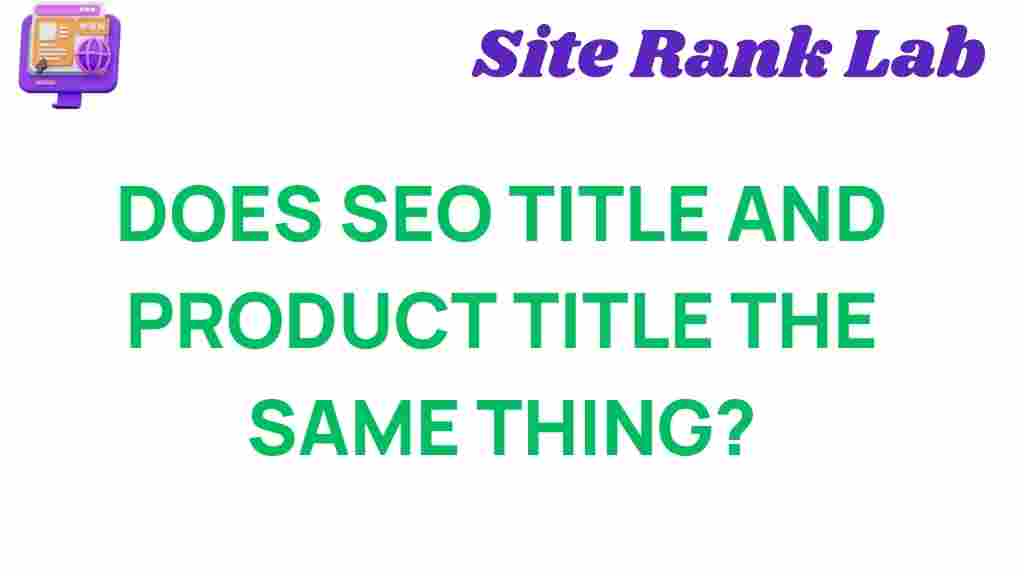Are SEO Titles and Product Titles the Same?
When it comes to e-commerce and online visibility, there is often confusion surrounding the terms “SEO titles” and “product titles.” Although they sound similar, their purposes and functionalities differ significantly. This article delves into the distinctions and overlaps between these two essential elements of online content, offering actionable tips to optimize them effectively for search engines and user experience alike.
Understanding SEO Titles
An SEO title is a meta title that appears in search engine results. It acts as a headline, enticing users to click through to your website. Optimized SEO titles not only improve your site’s ranking but also directly impact your click-through rate (CTR). They typically include the primary keyword, are concise, and adhere to a recommended character length (50-60 characters).
For example, a well-crafted SEO title for a page selling running shoes might be: “Best Running Shoes for 2024 | Lightweight and Durable”.
What Are Product Titles?
On the other hand, product titles describe the name of a product on an e-commerce platform or website. They are often more detailed and include brand names, product specifications, or model numbers to help users identify the item.
For instance, a product title for running shoes might read: “Nike Air Zoom Pegasus 40 – Men’s Running Shoes, Size 10”.
Key Differences Between SEO Titles and Product Titles
While both SEO titles and product titles aim to attract attention, their contexts and applications vary. Here are the primary differences:
- Purpose: SEO titles are designed for search engines, while product titles focus on user clarity and detail.
- Length: SEO titles are shorter to fit within search engine result pages, whereas product titles can be more descriptive.
- Keywords: SEO titles prioritize targeted keywords, while product titles include detailed specifications.
- Audience: SEO titles target searchers, whereas product titles cater to buyers who are further along the purchasing funnel.
Do They Overlap?
Despite their differences, SEO titles and product titles can overlap. For example, including important keywords in your product titles can enhance their visibility on search engines. However, simply copying product titles as SEO titles is not always effective. Instead, tailoring them to different audiences is crucial for maximizing their impact.
How to Optimize SEO Titles and Product Titles
Now that we understand their distinctions, let’s explore the best practices for optimizing both SEO titles and product titles.
Steps to Crafting Effective SEO Titles
- Include Primary Keywords: Place your main keyword near the beginning of the title.
- Maintain Proper Length: Keep the title between 50-60 characters to avoid truncation in search results.
- Use Actionable Language: Phrases like “Buy Now,” “Explore,” or “Learn More” can boost CTR.
- Incorporate Brand Names (When Relevant): Adding a brand name can improve recognition and trust.
- Test Variations: Use A/B testing tools to experiment with different titles and identify which performs better.
Best Practices for Product Titles
- Be Specific: Include critical details like brand, model, size, and color.
- Focus on Readability: Avoid stuffing titles with keywords; ensure they are easy to understand.
- Use Consistent Formatting: Standardized formats help users and search engines navigate your site efficiently.
- Highlight Unique Selling Points: If your product has a standout feature, make sure it’s mentioned.
- Adapt for Platforms: For marketplaces like Amazon, follow their title formatting guidelines strictly.
Troubleshooting Common Challenges
Striking the perfect balance between SEO and product titles can be tricky. Here are some common issues and how to address them:
Problem: SEO Titles Are Too Long
Overly long titles may get cut off in search results, reducing their effectiveness. Trim unnecessary words and focus on concise phrasing. Tools like Google’s SERP snippet generator can help preview how your title will appear.
Problem: Product Titles Lack Clarity
If your product titles are unclear, they may confuse potential buyers. To resolve this, ensure titles are specific, well-structured, and free from jargon.
Problem: Low Click-Through Rates
Low CTRs often indicate a disconnect between your SEO title and user intent. Test more engaging language or better align your titles with the search queries you’re targeting.
The Impact of Well-Optimized Titles
Properly optimized titles, whether for SEO or products, drive significant benefits:
- Improved Rankings: Search engines prioritize content with clear, relevant SEO titles.
- Higher Engagement: Users are more likely to click on links with compelling SEO titles and buy products with clear, attractive product titles.
- Enhanced User Experience: Descriptive titles make navigation easier for users.
For a deeper understanding of meta titles and their influence, check out this guide from Moz.
Final Thoughts
While SEO titles and product titles serve different purposes, both play an integral role in driving traffic and conversions. By understanding their distinctions and following best practices for optimization, you can leverage these elements to boost your site’s performance and deliver a superior user experience.
To learn more about enhancing your website’s SEO strategy, visit our comprehensive guide to SEO.
This article is in the category SEO and created by SiteRankLab Team
